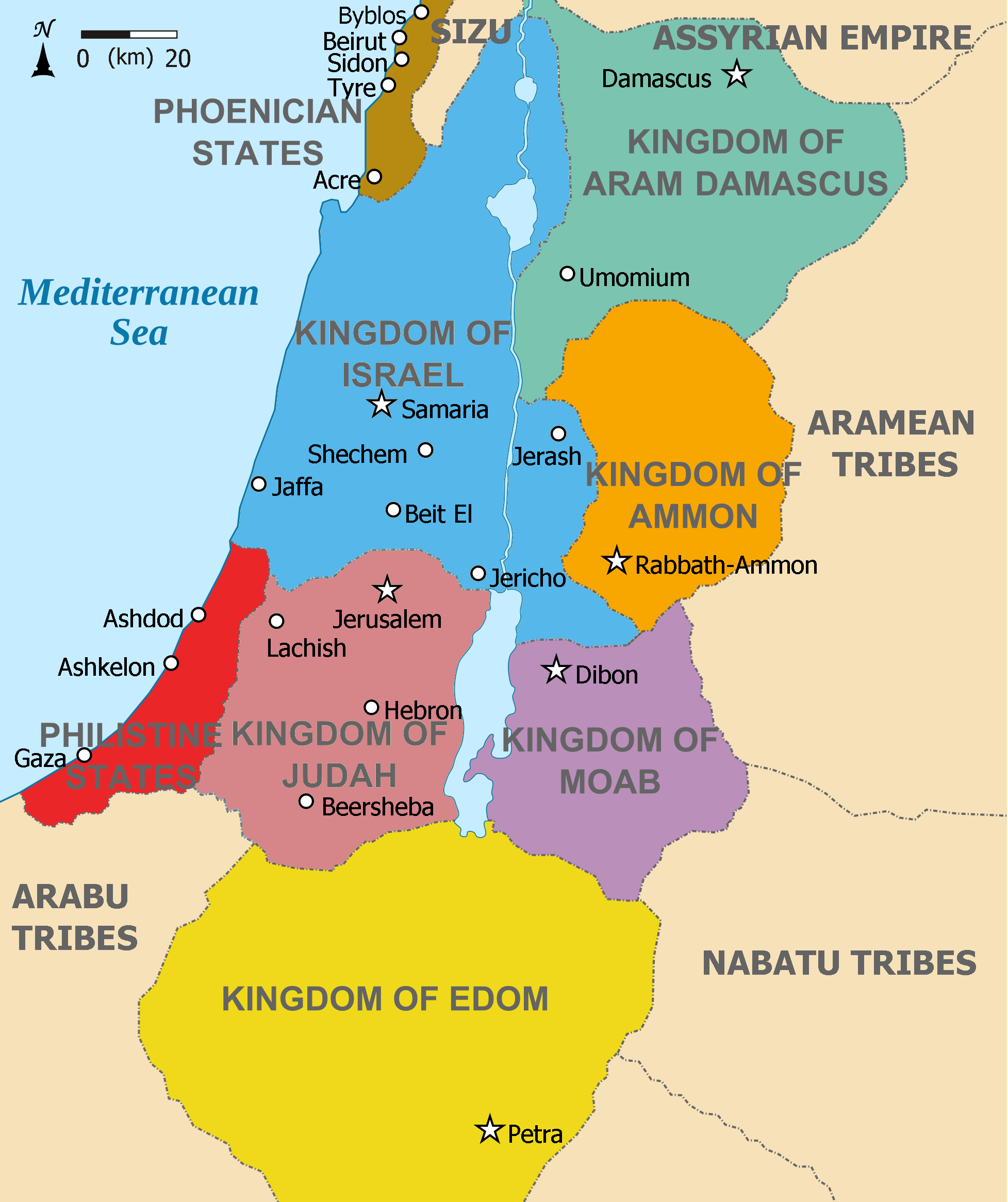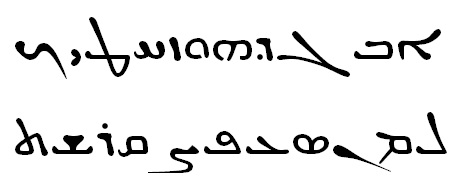|
Aramaean
The Arameans, or Aramaeans (; ; , ), were a tribal Semitic people in the ancient Near East, first documented in historical sources from the late 12th century BCE. Their homeland, often referred to as the land of Aram, originally covered central regions of what is now Syria. The Arameans were not a single nation or group; Aram was a region with local centers of power spread throughout the Levant. That makes it almost impossible to establish a coherent ethnic category of "Aramean" based on extralinguistic identity markers, such as material culture, lifestyle, or religion. The people of Aram were called "Arameans" in Assyrian texts and the Hebrew Bible, but the terms "Aramean" and “Aram” were never used by later Aramean dynasts to refer to themselves or their country, except the king of Aram-Damascus, since his kingdom was also called Aram. "Arameans" is merely an appellation of the geographical term Aram given to 1st millennium BCE inhabitants of Syria. At the beginnin ... [...More Info...] [...Related Items...] OR: [Wikipedia] [Google] [Baidu] |
Aram (region)
Aram (; ; ) was a historical region mentioned in early cuneiforms and in the Bible. The area did not develop into a larger empire but consisted of several small states in present-day Syria. Some of the states are mentioned in the Hebrew Bible, Aram-Damascus being the most outstanding one, which came to encompass most of Syria. In the Bible, Aram-Damascus is simply commonly referred to as Aram. After the final conquest by the rising Neo-Assyrian Empire in the second half of the 8th century and also during the later consecutive rules of the Neo-Babylonian Empire (612–539 BCE) and the Achaemenid Empire (539–332 BCE), the region of Aram lost most of its sovereignty. During the Seleucid period (312-64 BCE), the term ''Syria'' was introduced as Hellenistic designation for this region. By the beginning of the 5th century, that practice also started to affect terminology of Aramean ecclesiastical and literary elites, and ''Syrian'' labels started to gain frequency and acceptance not ... [...More Info...] [...Related Items...] OR: [Wikipedia] [Google] [Baidu] |
Syro-Hittite States
The states called Neo-Hittite, Syro-Hittite (in older literature), or Luwian-Aramean (in modern scholarly works) were Luwian and Aramean regional polities of the Iron Age, situated in southeastern parts of modern Turkey and northwestern parts of modern Syria, known in ancient times as lands of Hatti and Aram. They arose following the collapse of the Hittite New Kingdom in the 12th century BCE, and lasted until they were subdued by the Assyrian Empire in the 8th century BCE. They are grouped together by scholars, on the basis of several cultural criteria, that are recognized as similar and mutually shared between both societies, northern ( Luwian) and southern ( Aramaean). Cultural exchange between those societies is seen as a specific regional phenomenon, particularly in light of significant linguistic distinctions between the two main regional languages, with Luwian belonging to the Anatolian group of Indo-European languages and Aramaic belonging to the Northwest Semitic gr ... [...More Info...] [...Related Items...] OR: [Wikipedia] [Google] [Baidu] |
Aram-Damascus
Aram-Damascus ( ) was an Arameans, Aramean polity that existed from the late-12th century BCE until 732 BCE, and was centred around the city of Damascus in the Southern Levant. Alongside various tribal lands, it was bounded in its later years by the polities of Assyria to the north, Ammon to the south, and Kingdom of Israel (Samaria), Israel to the west. The compound name "Aram-Damascus" is only found in the Hebrew Bible, where it sometimes also is referred to as simply "Aram" or "Damascus". It is also referred to as "Aram" in some Aramaic inscriptions. In Assyrian sources, "Aram" was never used to designate it. It was often referred to as "Damascus" or "imērīšu" (meaning "his donkey"), and sometimes "Bīt-Ḫaza’ili" (meaning "house of Hazael"), in Assyrian sources. History The Tanakh gives accounts of Aram-Damascus' history, mainly in its interaction with History of ancient Israel and Judah, Israel and Judah. There are biblical texts referencing battles that took place b ... [...More Info...] [...Related Items...] OR: [Wikipedia] [Google] [Baidu] |
Aramaic
Aramaic (; ) is a Northwest Semitic language that originated in the ancient region of Syria and quickly spread to Mesopotamia, the southern Levant, Sinai, southeastern Anatolia, and Eastern Arabia, where it has been continually written and spoken in different varieties for over three thousand years. Aramaic served as a language of public life and administration of ancient kingdoms and empires, particularly the Neo-Assyrian Empire, Neo-Babylonian Empire, and Achaemenid Empire, and also as a language of divine worship and religious study within Judaism, Christianity, and Gnosticism. Several modern varieties of Aramaic are still spoken. The modern eastern branch is spoken by Assyrians, Mandeans, and Mizrahi Jews.{{cite book , last1=Huehnergard , first1=John , author-link1=John Huehnergard , last2=Rubin , first2=Aaron D. , author-link2=Aaron D. Rubin , date=2011 , editor-last=Weninger , editor-first=Stefan , title=The Semitic Languages: An International Handbook , pub ... [...More Info...] [...Related Items...] OR: [Wikipedia] [Google] [Baidu] |
Terms For Syriac Christians
Terms for Syriac Christians are endonymic (native) and exonymic (foreign) terms, that are used as designations for Syriac Christians, as adherents of Syriac Christianity. In its widest scope, Syriac Christianity encompass all Christian denominations that follow East Syriac Rite or West Syriac Rite, and thus use Classical Syriac as their main liturgical language. Traditional divisions among Syriac Christians along denominational lines are reflected in the use of various theological and ecclesiological designations, both historical and modern. Specific terms such as: Jacobites, Saint Thomas Syrian Christians, Maronites, Melkites, Nasranis, and Nestorians have been used in reference to distinctive groups and branches of Eastern Christianity, including those of Syriac liturgical and linguistic traditions. Some of those terms are polysemic, and their uses (both historical and modern) have been a subject of terminological disputes between different communities, and also a ... [...More Info...] [...Related Items...] OR: [Wikipedia] [Google] [Baidu] |
Ancient Near East
The ancient Near East was home to many cradles of civilization, spanning Mesopotamia, Egypt, Iran (or Persia), Anatolia and the Armenian highlands, the Levant, and the Arabian Peninsula. As such, the fields of ancient Near East studies and Near Eastern archaeology are one of the most prominent with regard to research in the realm of ancient history. Historically, the Near East denoted an area roughly encompassing the centre of West Asia, having been focused on the lands between Greece and Egypt in the west and Iran in the east. It therefore largely corresponds with the modern-day geopolitical concept of the Middle East. The history of the ancient Near East begins with the rise of Sumer in the 4th millennium BC, though the date that it ends is a subject of debate among scholars; the term covers the region's developments in the Bronze Age and the Iron Age, and is variously considered to end with either the establishment of the Achaemenid Empire in the 6th century BC, the establi ... [...More Info...] [...Related Items...] OR: [Wikipedia] [Google] [Baidu] |
List Of Aramean Kings
Aramean kings were Monarch, kings of the ancient Arameans, and rulers of various Aram (region), Aramean states that existed throughout the Levant and Mesopotamia during the 14th and 13th centuries BC, before being absorbed by various other empires such as the Neo-Assyrian Empire, Neo-Babylonian Empire and the Achaemenid Empire. Kings Aramean kings are known from various inscriptions, and some are also mentioned in the Hebrew Bible. Aram-Damascus Bit Agusi, Bit-Agusi Sam'al, Bit-Gabbari (Sam'al) Kasku Aram-Zobah Bit Bahiani Hamath Aram-Naharaim Bit-Zamani Bit-Adini Palmyrene Empire See also * Aram (region) * Bit-Halupe * Gambulu * Luhuti * Maacah * Osroene * Paddan Aram * Syria (region) * History of Syria * List of Syrian monarchs References Sources * * * * {{DEFAULTSORT:Aramean kings Aramean kings, Lists of monarchs in Asia, Aram Syria history-related lists Iraq history-related lists ... [...More Info...] [...Related Items...] OR: [Wikipedia] [Google] [Baidu] |
Neo-Babylonian Empire
The Neo-Babylonian Empire or Second Babylonian Empire, historically known as the Chaldean Empire, was the last polity ruled by monarchs native to ancient Mesopotamia. Beginning with the coronation of Nabopolassar as the King of Babylon in 626 BC and being firmly established through the fall of the Neo-Assyrian Empire, Assyrian Empire in 612 BC, the Neo-Babylonian Empire was conquered by the Achaemenid Persian Empire in 539 BC, marking the collapse of the Chaldean dynasty less than a century after its founding. The defeat of the Assyrian Empire and subsequent return of power to Babylon marked the first time that the city, and southern Mesopotamia in general, had risen to dominate the ancient Near East since the collapse of the Old Babylonian Empire (under Hammurabi) nearly a thousand years earlier. The period of Neo-Babylonian rule thus saw unprecedented economic and population growth throughout Babylonia, as well as a renaissance of culture and artwork as Neo-Babylonian kings condu ... [...More Info...] [...Related Items...] OR: [Wikipedia] [Google] [Baidu] |
Imperial Aramaic
Imperial Aramaic is a linguistic term, coined by modern Aramaic studies, scholars in order to designate a specific historical Variety (linguistics), variety of Aramaic language. The term is polysemic, with two distinctive meanings, wider (sociolinguistic) and narrower (dialectological). Since most surviving examples of the language have been found in Egypt, the language is also referred to as Egyptian Aramaic. Some scholars use the term as a designation for a distinctive, socially prominent phase in the history of Aramaic language, that lasted from the middle of the 8th century BCE to the end of the 4th century BCE and was marked by the use of Aramaic as a language of public life and administration in the late Neo-Assyrian Empire and its successor states, the Neo-Babylonian Empire and the Achaemenid Empire, also adding to that some later (Post-Imperial) uses that persisted throughout the early Hellenistic period, Hellenistic period. Other scholars use the term ''Imperial Aramaic'' ... [...More Info...] [...Related Items...] OR: [Wikipedia] [Google] [Baidu] |
Syriac Language
The Syriac language ( ; ), also known natively in its spoken form in early Syriac literature as Edessan (), the Mesopotamian language () and Aramaic (), is an Aramaic#Eastern Middle Aramaic, Eastern Middle Aramaic dialect. Classical Syriac is the academic term used to refer to the dialect's literary usage and standardization, distinguishing it from other Aramaic dialects also known as 'Syriac' or 'Syrian'. In its West-Syriac Rite, West-Syriac tradition, Classical Syriac is often known as () or simply , or , while in its East-Syriac Rite, East-Syriac tradition, it is known as () or (). It emerged during the first century AD from a local Eastern Aramaic languages, Eastern Aramaic dialect that was spoken in the ancient region of Osroene, centered in the city of Edessa. During the Early Christian period, it became the main literary language of various Aramaic-speaking Christian communities in the historical region of Syria (region), Ancient Syria and throughout the Near East. As ... [...More Info...] [...Related Items...] OR: [Wikipedia] [Google] [Baidu] |
Levant
The Levant ( ) is the subregion that borders the Eastern Mediterranean, Eastern Mediterranean sea to the west, and forms the core of West Asia and the political term, Middle East, ''Middle East''. In its narrowest sense, which is in use today in archaeology and other cultural contexts, it is equivalent to Cyprus and a stretch of land bordering the Mediterranean Sea in Western AsiaGasiorowski, Mark (2016). ''The Government and Politics of the Middle East and North Africa''. p. 5: "... today the term ''Levantine'' can describe shared cultural products, such as Levantine cuisine or Levantine archaeology". .Steiner & Killebrew, p9: "The general limits ..., as defined here, begin at the Plain of 'Amuq in the north and extend south until the Wâdī al-Arish, along the northern coast of Sinai. ... The western coastline and the eastern deserts set the boundaries for the Levant ... The Euphrates and the area around Jebel el-Bishrī mark the eastern boundary of the northern Levant, as d ... [...More Info...] [...Related Items...] OR: [Wikipedia] [Google] [Baidu] |
Hebrew Bible
The Hebrew Bible or Tanakh (;"Tanach" . '' Random House Webster's Unabridged Dictionary''. ; ; or ), also known in Hebrew as (; ), is the canonical collection of scriptures, comprising the Torah (the five Books of Moses), the Nevi'im (the Books of the Prophets), and the [...More Info...] [...Related Items...] OR: [Wikipedia] [Google] [Baidu] |






